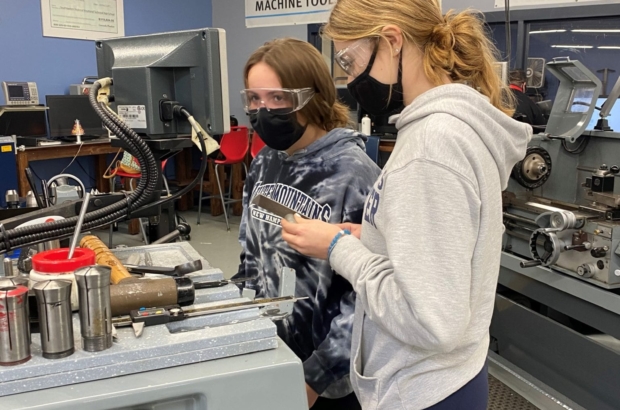Voc-tech schools thriving despite pandemic strictures
This op-ed originally appeared in CommonWealth Magazine.
HANDS-ON EDUCATION plays a critical role at Massachusetts regional vocational-technical high schools, where students alternate weekly between academics and shop classes. Given that reality, you’d think the schools would be particularly hard hit by the switch to hybrid models under which students are in a physical school building only half the time. But thanks to innovative approaches to coping with pandemic-related restrictions, voc-techs are successfully bucking statewide public-school enrollment trends.
Enrollment in traditional public schools in Massachusetts is off by more than 5 percent this year. But nearly 4 percent more students are attending charter public schools and regional vocational-technical high schools have seen a 2-percent enrollment increase.
In September, biotechnology students at Essex North Shore Agricultural and Technical School in Danvers, where students alternate every two weeks between in-person and online learning, began an animal cell culture experiment. After preparing their reports remotely, they presented the findings in person.
You might be surprised to hear about voc-tech students performing an experiment in which they exposed Chinese hamster ovary cells to varying concentrations of Juul e-liquid to study how the liquid, which contains nicotine, affects the growth and viability of the cells. Voc-tech students are conducting advanced scientific research that is preparing them well for college. Today, two thirds of graduates go on to higher education.
The state’s 1993 Education Reform Act included voc-techs when it required that students pass MCAS tests to graduate from high school. Despite initial resistance, voc-techs ultimately embraced MCAS and the schools succeeded at enhancing academics without compromising their occupational education mission.
Voc-tech schools have large shop spaces that can accommodate social distancing. Other adjustments are also being made to accommodate hands-on learning during the pandemic.
In auto technology classes, two students would routinely have their heads under the hood of a car or truck at the same time. Now one might be studying the engine, while the other works on the other end of the vehicle. Instead of the instructor leaning in with students to check their work, the students step away to allow the instructor to inspect the work and provide feedback.
Some voc-techs are using in-person time for hands-on learning and doing academics remotely, while others are switching between remote and in person for both.
Online shop classes are made easier by the millions of dollars’ worth of training devices located at the schools, which are perfect for live or video demonstrations. Many teachers are shooting instructional videos from the field.
When it comes to the popularity of regional vocational-technical schools, the pandemic is only accelerating the long-term trend. Between 2005 and this year, voc-tech enrollment is up 24 percent.
That’s no accident. Despite spending only half their time on academics, vocational-technical high schools match their comprehensive high school counterparts on state test scores and their students show inordinate academic growth from ninth grade on.
Even as technical jobs demand ever-higher skill levels, vocational-technical high schools are keeping pace, thanks in part to the close relationships the schools have forged with area employers. Those relationships ensure that voc-techs continue to produce students with the skills and credentials businesses need, and they also yield equipment and other donations from employers eager to keep the talent pipeline flowing.
Even though voc-techs serve more low-income and special needs students than comprehensive high schools, their dropout rate is just a third of that of their more traditional counterparts. Among special education students, the voc-tech graduation rate is 24 percentage points higher.
Keeping up with rapid technological and economic changes is one of the secrets of the success of Massachusetts regional vocational-technical high schools. Now, the same kind of innovation that keeps those schools on the cutting edge is being applied to overcoming the challenges presented by the COVID-19 pandemic.



